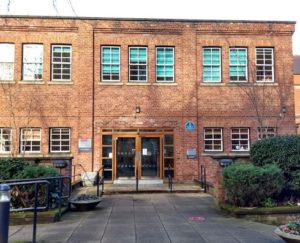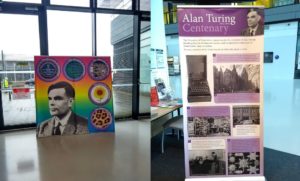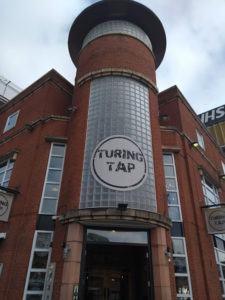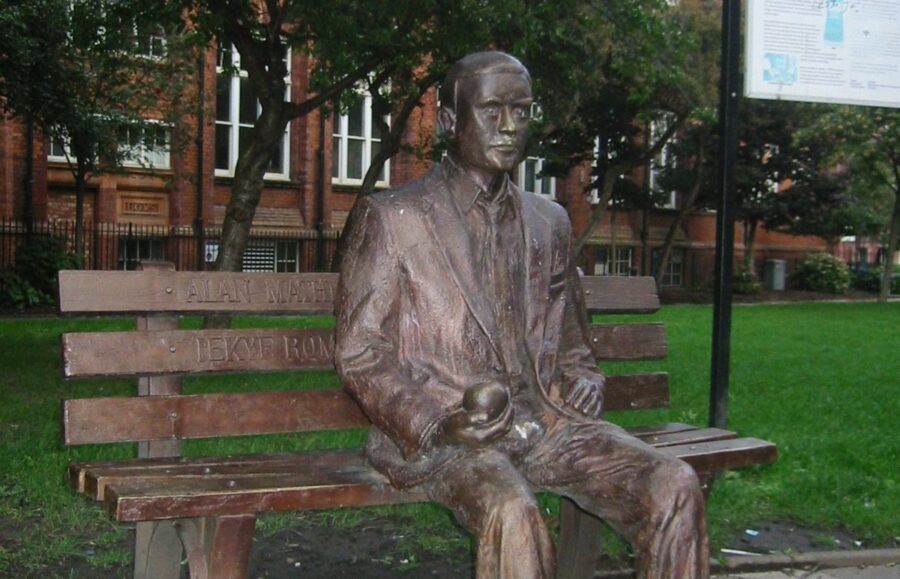Alan Turing (1912–1954) is kind of a big deal around Manchester, especially at the University. Whenever I have guests visiting me here, I always make it a point to tell them about Alan Turing and to show them some his old office on campus. I’ll give a (very) brief bio about Alan Turing before mentioning some sights in his honour one might encounter around the University.
Who was Alan Turing?
I’ll just share a few biographical details about Alan Turing here, but a detailed biography can be found here, including details on his time in Manchester. The University of Manchester’s Maths history bio is also nice and succinct.
Alan Turing was a computer scientist and a hero of the Second World War. As part of the Government Code and Cypher School, his contributions facilitated the code-breaking of Nazi messages which in turn allowed Allied forces to prevent or intercept potentially devastating manoeuvres and attacks. His many contributions to mathematics and computer science before and after the Second World War have earned him a reputation as a leading figure and forerunner in his fields, including artificial intelligence.
Turing was appointed Reader in the Mathematics Department at the University of Manchester in 1948, and in that same year he became Deputy Director of the Computing Laboratory. He was arrested and faced trial four years later in 1952 for ‘gross indecency’ over allegations of a homosexual relationship with a local, which Turing did not deny or think to be a significant crime. Yet, in order to avoid a prison sentence he was required to take injections of Diethylstilbestrol for a year, a form of chemical castration. In 1954, at the age of 41, Turing died from cyanide poisoning, apparently injected into an apple which remained half-eaten by his side.1 Many years later, at the turn of the 21st century, official statements were made about the inappropriate treatment of Turing and he was pardoned of his conviction.
A magnificent film was recently made about Alan Turing entitled The Imitation Game, staring Benedict Cumberbatch who actually studied Drama at the University of Manchester.2 Much of the movie takes place in Cambridge and his time outside of Manchester during the Second World War. I highly recommend watching this if you haven’t already seen it.
Sights around the University remembering Alan Turing
There are a number of reminders around the University of Manchester about Alan Turing and his legacy. His old office was in Coupland Building 1 (see also the University’s details about this here). I attended our weekly seminar in this building on a few occasions. When I am giving my guests a tour of the campus this is always a high priority location on my list!

The Alan Turing Building was completed in 2007 and became the home for the School of Mathematics. I am in this building on a weekly basis at the moment, though not for Maths. The architecture is really nice on the inside. The atrium has a fancy business feel to it.

If this weren’t enough, just outside of campus is a great pub called Turing Tap. It’s a great atmosphere with good beers, smashing pies, and football matches on the telly. I frequent this particular facility before catching a bus home or to watch football.

You can also see the Alan Turing Memorial Statue at Sackville Park in town (pictured in the cover image).
If you find yourself around Manchester, take a moment to honour the father of computer science and Second World War hero, Alan Turing. If you’re ever my guest here, I’ll certainly remind you and show you these locations!
Endnotes
1. Andrew Hodges, ‘Alan Turing — a short biography,’ on [Website] Alan Turing: The Enigma, an electronic extension of the biography (1995). Available at: http://www.turing.org.uk/publications/dnb.html, (Accessed: 06 March 2018).
2. See http://www.imdb.com/name/nm1212722/bio?ref_=nm_ov_bio_sm.


Leave a Reply
Your email is safe with us.